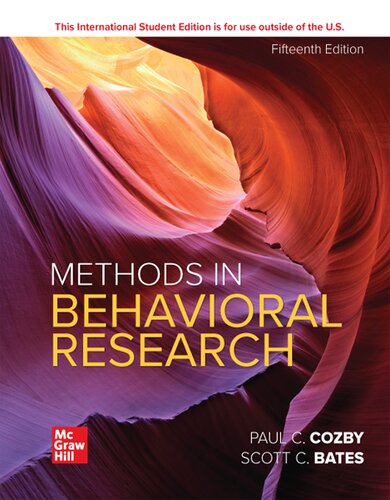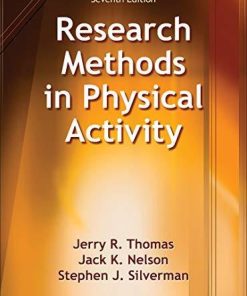Methods in Behavioral Research 15th Edition by Paul Cozby 1260883077 9781260883077
$50.00 Original price was: $50.00.$25.00Current price is: $25.00.
Methods in Behavioral Research 15th Edition by Paul C. Cozby – Ebook PDF Instant Download/DeliveryISBN: 1260883077, 9781260883077
Full download Methods in Behavioral Research 15th Edition after payment.

Product details:
ISBN-10 : 1260883077
ISBN-13 : 9781260883077
Author: Paul C. Cozby
Methods in Behavioral Research
Methods in Behavioral Research 15th Table of contents:
Chapter 1: Scientific Understanding of Behavior
Chapter 1 Introduction
Consuming Research
Why Learn about Research Methods?
Ways of Knowing
Intuition
Authority
Empiricism
The Scientific Approach
Skepticism
Being a Skilled Consumer of Research
Goals of Behavioral Science
Description
Prediction
Determining Causes
Explaining Behavior
Basic and Applied Research
Basic Research
Applied Research
Comparing Basic and Applied Research
Chapter Review
Review Questions
Study Terms
Chapter 2: Where to Start
Chapter 2 Introduction
Research Questions, Hypotheses, and Predictions
Sources of Ideas
Common Sense
Practical Problems
Observation of the World Around Us
Theories
Past Research
Types of Journal Articles
Literature Reviews
Theory Articles
Empirical Research Articles
Exploring Past Research
Journals
Online Scholarly Research Databases
Conducting an APA PsycInfo Search
Web of Science & Scopus
Other Electronic Search Resources
Chapter Review
Review Questions
Study Terms
Chapter 3: Ethics in Behavioral Research
Chapter 3 Introduction
Milgram’s Obedience Experiments
Historical Context of Current Ethical Standards
The Nuremberg Code, the Declaration of Helsinki, and the Belmont Report
APA Ethics Code
APA Ethics Code: Five Principles
Assessment of Risks and Benefits
Risks in Behavioral Research
Informed Consent
Informed Consent Form
Autonomy Issues
Withholding Information and Deception
The Importance of Debriefing
Institutional Review Boards
Determining Type of IRB Review
Research with Nonhuman Animal Subjects
Being an Ethical Researcher: The Issue of Misrepresentation
Fraud
Plagiarism
Conclusion: Risks and Benefits Revisited
Chapter Review
Review Questions
Study Terms
Chapter 4: Fundamental Research Issues
Chapter 4 Introduction
Validity: An Introduction
Variables
Operational Definitions of Variables
Construct Validity
Relationships Between Variables
Positive Linear Relationship
Negative Linear Relationship
Curvilinear Relationship
No Relationship
Relationships and Reduction of Uncertainty
Nonexperimental Versus Experimental Methods
Nonexperimental Method
Experimental Method
Internal Validity and the Experimental Method
Independent and Dependent Variables
Experimental Methods: Additional Considerations
Experiments Are Tightly Controlled, Unlike the Real World
Some Variables Cannot Be—or Should Not Be—Manipulated
Some Questions Are Not Answerable by an Experiment
Advantages of Multiple Methods
Evaluating Research: Summary of the Four Validities
Chapter Review
Review Questions
Study Terms
Chapter 5: Measurement Concepts
Chapter 5 Introduction
Reliability of Measures
Test-Retest Reliability
Internal Consistency Reliability
Interrater Reliability
Reliability and Accuracy of Measures
Construct Validity of Measures
Indicators of Construct Validity
Measurement Validity: For Whom
Reactivity of Measures
Variables and Measurement Scales
Nominal Scales
Ordinal Scales
Interval and Ratio Scales
The Importance of the Measurement Scales
Chapter Review
Review Questions
Study Terms
Chapter 6: Observational Methods
Chapter 6 Introduction
Quantitative and Qualitative Approaches
Naturalistic Observation
Description and Interpretation of Data
Participation and Concealment
Limits of Naturalistic Observation
Systematic Observation
Coding Systems
Methodological Issues
Case Studies
Archival Research
Statistical Records
Survey Archives
Written, Audio, and Video Records
Chapter Review
Review Questions
Study Terms
Chapter 7: Asking People About Themselves: Survey Research
Chapter 7 Introduction
Why Conduct Surveys?
Constructing Questions to Ask
Defining the Research Objectives
Question-Wording
Responses to Questions
Closed-Ended Versus Open-Ended Questions
Number of Response Alternatives
Rating Scales
Labeling Response Alternatives
Finalizing the Survey Instrument
Formatting
Sequence of Questions
Refining Questions: Pilot Testing the Survey
Administering Surveys
Questionnaires
Interviews
Survey Designs to Study Changes Over Time
Sampling From a Population
Confidence Intervals
Sample Size
Sampling Techniques
Probability Sampling
Nonprobability Sampling
Evaluating Samples
Sampling Frame
Response Rate
Reasons for Using Convenience Samples
Chapter Review
Review Questions
Study Terms
Chapter 8: Experimental Design
Chapter 8 Introduction
Confounding Variables and Internal Validity
Basic Experiments
Posttest-Only Design
Pretest-Posttest Design
Comparing Posttest-Only and Pretest-Posttest Designs
Assigning Participants to Experimental Conditions
Independent Groups Design
Repeated Measures Design
Matched Pairs Design
Chapter Review
Review Questions
Study Terms
Chapter 9: Conducting Experiments
Chapter 9 Introduction
Selecting Research Participants
Manipulating the Independent Variable
Setting the Stage
Types of Manipulations
Strength of the Manipulation
Cost of the Manipulation
Measuring the Dependent Variable
Types of Measures
Multiple Measures
Sensitivity of the Dependent Variable
Cost of Measures
Additional Controls
Controlling for Participant Expectations
Controlling for Experimenter Expectations
Final Planning Considerations
Research Proposals
Pilot Studies
Manipulation Checks
Debriefing
Open Science and Preregistration
Analyzing and Interpreting Results
Communicating Research to Others
Professional Meetings
Journal Articles
Chapter Review
Review Questions
Study Terms
Chapter 10: Complex Experimental Designs
Chapter 10 Introduction
Increasing the Number of Levels of an Independent Variable
Increasing the Number of Independent Variables: Factorial Designs
Interpretation of Factorial Designs
Outcomes of a 2 × 2 Factorial Design
Interactions and Simple Main Effects
Assignment Procedures and Factorial Designs
Independent Groups (between-subjects) Design
Repeated Measures (within-subjects) Design
Mixed Factorial Design Using Combined Assignment
From 2 x 2 to N x N Factorial Designs
Factorial Designs with Three or More Independent Variables
Chapter Review
Review Questions
Study Terms
Chapter 11: Single-Case, Quasi-Experimental, and Developmental Research
Chapter 11 Introduction
Single-Case Experimental Designs
Reversal Designs
Multiple Baseline Designs
Replications in Single-Case Designs
Quasi-Experimental Designs
One-Group Posttest-Only Design
One-Group Pretest-Posttest Design
Nonequivalent Control Group Design
Nonequivalent Control Group Pretest-Posttest Design
Propensity Score Matching of Nonequivalent Treatment and Control Groups
Interrupted Time Series Design and Control Series Design
Developmental Research Designs
Cross-Sectional Method
Longitudinal Method
Comparison of Longitudinal and Cross-Sectional Methods
Sequential Method
Chapter Review
Review Questions
Study Terms
Chapter 12: Understanding Research Results: Description and Correlation
Chapter 12 Introduction
Scales of Measurement: A Review
Describing Results
Comparing Group Percentages
Correlating Individual Scores
Comparing Group Means
Frequency Distributions
Graphing Frequency Distributions
Descriptive Statistics
Central Tendency
Variability
Graphing Relationships
Correlation Coefficients: Describing the Strength of Relationships
Pearson r Correlation Coefficient
Important Considerations
Effect Size
Regression Equations
Multiple Correlation and Regression
Mediating and Moderating Variables
Mediation
Moderation
Third Variables
Advanced Statistical Analyses
Chapter Review
Review Questions
Study Terms
Chapter 13: Understanding Research Results: Statistical Inference
Chapter 13 Introduction
Samples and Populations
Inferential Statistics
Null and Research Hypotheses
Probability and Sampling Distributions
Probability: The Case of ESP
Sampling Distributions
Sample Size
Group Differences: The t and F Tests
t Test
Degrees of Freedom
One-Tailed Versus Two-Tailed Tests
F Test
Calculating Effect Size
Confidence Intervals and Statistical Significance
Statistical Significance: An Overview
Type I and Type II Errors
Correct Decisions
Type I Errors
Type II Errors
The Everyday Context of Type I and Type II Errors
Choosing a Significance Level
Interpreting Nonsignificant Results
Choosing a Sample Size: Power Analysis
The Importance of Replications
Significance of a Pearson r Correlation Coefficient
Statistical Analysis Software
Selecting the Appropriate Statistical Test
Research Studying Two Variables (Bivariate Research)
Research with Multiple Independent Variables
Chapter Review
Review Questions
Study Terms
Chapter 14: Generalization
Chapter 14 Introduction
Generalizing Across People
Sex and Gender Identity
Racial and Ethnic Identity
Culture
Threats to External Validity
Nonhuman Animals
Generalizing Across Situations
Replications
Exact Replications
Conceptual Replications
Assessing External Validity Via Literature Reviews and Meta-Analyses
Using Research to Improve Lives
Chapter Review
Review Questions
Study Terms
Appendix A: Reporting Research
Introduction
Writing Your Report
Clarity
Acknowledging the Work of Others
Active Versus Passive Voice
Avoiding Biased Language
Some Grammatical Considerations
Troublesome Words and Phrases
Formatting Your Report
Professional and Student Paper Formats
Organization of the Report
Title Page
Abstract
Body of the Paper
References
Tables
Figures
Appendix and Supplemental Materials
The Use of Headings
Citing Sources and Creating a Reference List
Citation Style
Reference List Style
Abbreviations
Reporting Numbers and Statistics
Paper and Poster Presentations
People also search for Methods in Behavioral Research 15th:
cozby and bates methods in behavioral research
methods in behavioral research 14th edition pdf
borrow methods in behavioral research
methods in behavioral research 14th edition
methods in behavioral research pdf
Tags: Methods, Behavioral Research, Paul Cozby, Behavioral
You may also like…
Psychology - Pedagogy
Computers - Computer Science
Politics & Philosophy - Social Sciences
Earth Sciences - Geology
Communication
Uncategorized












